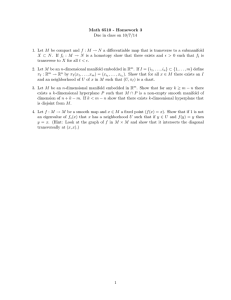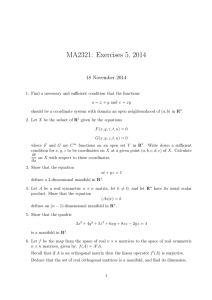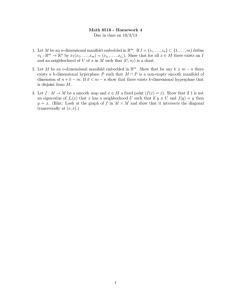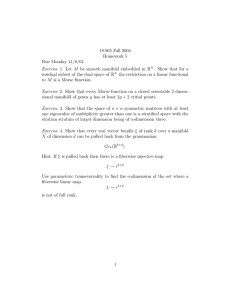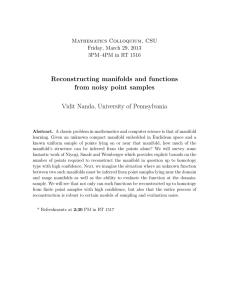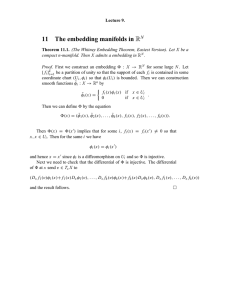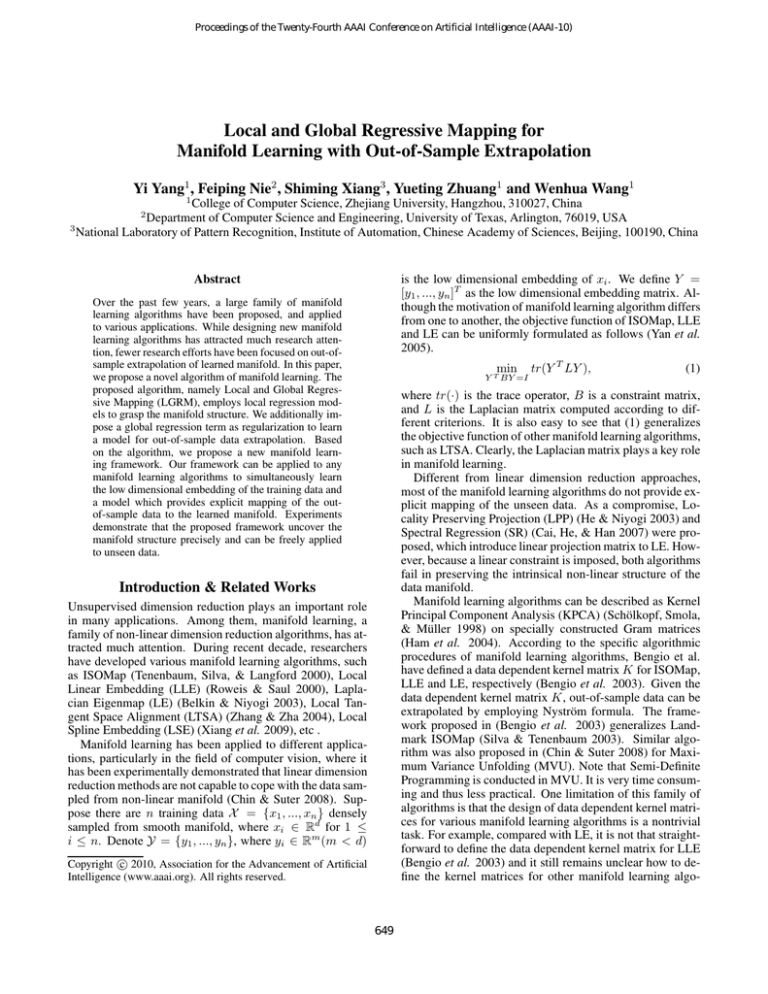
Proceedings of the Twenty-Fourth AAAI Conference on Artificial Intelligence (AAAI-10)
Local and Global Regressive Mapping for
Manifold Learning with Out-of-Sample Extrapolation
Yi Yang1 , Feiping Nie2 , Shiming Xiang3 , Yueting Zhuang1 and Wenhua Wang1
1
College of Computer Science, Zhejiang University, Hangzhou, 310027, China
Department of Computer Science and Engineering, University of Texas, Arlington, 76019, USA
3
National Laboratory of Pattern Recognition, Institute of Automation, Chinese Academy of Sciences, Beijing, 100190, China
2
is the low dimensional embedding of xi . We define Y =
[y1 , ..., yn ]T as the low dimensional embedding matrix. Although the motivation of manifold learning algorithm differs
from one to another, the objective function of ISOMap, LLE
and LE can be uniformly formulated as follows (Yan et al.
2005).
Abstract
Over the past few years, a large family of manifold
learning algorithms have been proposed, and applied
to various applications. While designing new manifold
learning algorithms has attracted much research attention, fewer research efforts have been focused on out-ofsample extrapolation of learned manifold. In this paper,
we propose a novel algorithm of manifold learning. The
proposed algorithm, namely Local and Global Regressive Mapping (LGRM), employs local regression models to grasp the manifold structure. We additionally impose a global regression term as regularization to learn
a model for out-of-sample data extrapolation. Based
on the algorithm, we propose a new manifold learning framework. Our framework can be applied to any
manifold learning algorithms to simultaneously learn
the low dimensional embedding of the training data and
a model which provides explicit mapping of the outof-sample data to the learned manifold. Experiments
demonstrate that the proposed framework uncover the
manifold structure precisely and can be freely applied
to unseen data.
min
Y T BY =I
tr(Y T LY ),
(1)
where tr(·) is the trace operator, B is a constraint matrix,
and L is the Laplacian matrix computed according to different criterions. It is also easy to see that (1) generalizes
the objective function of other manifold learning algorithms,
such as LTSA. Clearly, the Laplacian matrix plays a key role
in manifold learning.
Different from linear dimension reduction approaches,
most of the manifold learning algorithms do not provide explicit mapping of the unseen data. As a compromise, Locality Preserving Projection (LPP) (He & Niyogi 2003) and
Spectral Regression (SR) (Cai, He, & Han 2007) were proposed, which introduce linear projection matrix to LE. However, because a linear constraint is imposed, both algorithms
fail in preserving the intrinsical non-linear structure of the
data manifold.
Manifold learning algorithms can be described as Kernel
Principal Component Analysis (KPCA) (Schölkopf, Smola,
& Müller 1998) on specially constructed Gram matrices
(Ham et al. 2004). According to the specific algorithmic
procedures of manifold learning algorithms, Bengio et al.
have defined a data dependent kernel matrix K for ISOMap,
LLE and LE, respectively (Bengio et al. 2003). Given the
data dependent kernel matrix K, out-of-sample data can be
extrapolated by employing Nyström formula. The framework proposed in (Bengio et al. 2003) generalizes Landmark ISOMap (Silva & Tenenbaum 2003). Similar algorithm was also proposed in (Chin & Suter 2008) for Maximum Variance Unfolding (MVU). Note that Semi-Definite
Programming is conducted in MVU. It is very time consuming and thus less practical. One limitation of this family of
algorithms is that the design of data dependent kernel matrices for various manifold learning algorithms is a nontrivial
task. For example, compared with LE, it is not that straightforward to define the data dependent kernel matrix for LLE
(Bengio et al. 2003) and it still remains unclear how to define the kernel matrices for other manifold learning algo-
Introduction & Related Works
Unsupervised dimension reduction plays an important role
in many applications. Among them, manifold learning, a
family of non-linear dimension reduction algorithms, has attracted much attention. During recent decade, researchers
have developed various manifold learning algorithms, such
as ISOMap (Tenenbaum, Silva, & Langford 2000), Local
Linear Embedding (LLE) (Roweis & Saul 2000), Laplacian Eigenmap (LE) (Belkin & Niyogi 2003), Local Tangent Space Alignment (LTSA) (Zhang & Zha 2004), Local
Spline Embedding (LSE) (Xiang et al. 2009), etc .
Manifold learning has been applied to different applications, particularly in the field of computer vision, where it
has been experimentally demonstrated that linear dimension
reduction methods are not capable to cope with the data sampled from non-linear manifold (Chin & Suter 2008). Suppose there are n training data X = {x1 , ..., xn } densely
sampled from smooth manifold, where xi ∈ Rd for 1 ≤
i ≤ n. Denote Y = {y1 , ..., yn }, where yi ∈ Rm (m < d)
c 2010, Association for the Advancement of Artificial
Copyright Intelligence (www.aaai.org). All rights reserved.
649
rithms, i.e., LTSA.
In (Saul & Roweis 2003), a nonparametric approach
was proposed for out-of-sample extrapolation of LLE. Let
xo ∈ Rd be the novel data to be extrapolated and Xo =
{xo1 , ..., xok } ⊂ X be a set of data which are k nearest
neighbor set of xo in Rd . The low dimensional embedding
P
yo of xo is given by ki=1 wi yoi , in which yoi is the low
dimensional embedding of xoi and wi (1 ≤ i ≤ k) can be
obtained by minimizing the following objective function.
Xk
Xk
2
min
kxo − wi xoi k , s.t.
wi = 1.
(2)
i=1
regularization parameter. Note that our objective is intrinsically different from (Wu & Schölkopf 2006) which only utilizes a local learning model to predict the cluster identification of a single datum in Ni . Traditional manifold learning
aims to map each datum xi ∈ X to yi ∈ Y. Alternatively,
our framework additionally learns a mapping function which
can be used to cope with unseen data. We therefore propose
to minimize the following objective function:
Xn X
min
ℓ(fi (xj ), yj ) + γΩ(fi )
i=1
Y T Y =I,fi ,f
i
xj ∈Ni
Xn
+
This algorithm is a general one and can be applied to any
other manifold learning algorithms for out-of-sample data
extrapolation. A limitation is that, as indicated in (Saul
& Roweis 2003), the mapping may discontinuously change
as the novel points move between different neighborhoods.
Furthermore, if the novel data are off manifold, i.e., the locally linear condition is not satisfied, it is uncertain how the
algorithm will behave (Chin & Suter 2008).
In this paper, we propose a new manifold learning algorithm, namely Local and Global Regressive Mapping
(LGRM), which learns a novel Laplacian matrix for manifold learning. In the proposed algorithm, we additionally
add a kernelized global regression regularization to learn a
model, which is used to extrapolate the unseen data. Based
on the algorithm, we propose a new framework, which can
be applied to many other manifold learning algorithms for
out-of-sample data extrapolation. An interesting observation is that several well-known unsupervised dimension reduction algorithms are special cases of our framework. We
observe in the experiment that the proposed algorithm preserves the manifold structure precisely during the projection
and it works well when applied to unseen data.
The rest of this paper is organized as follows. Firstly, we
detail the proposed algorithm. Then, based on the new algorithm, we propose a new framework for manifold learning and discuss the connections between our algorithm and
other existing algorithms. After that, we show the experimental results and give conclusions.
i=1
ℓ (f (xi ), yi ) + γΩ(f ). (4)
Different from all of the previous manifold learning algorithms, such as ISOMap, LLE, LE and LTSA, the objective
function shown in (4) not only learns the low dimensional
embedding Y of the input data, but also learns a mapping
function f : Rd → Rm for out-of-sample data extrapolation. Observing the connection between KPCA and manifold learning, we first map the data into a Hilbert space H
and assume that there is a linear transformation between H
and Rm , i.e. yi = φ(W )T φ(xi ) + b, where φ(W ) is the projection matrix from H to Rm and b ∈ Rm is bias term. The
data number in Ni is usually small. Following (Zhang &
Zha 2004), we perform local PCA to reduce the dimension
of each datum in Ni as preprocessing to avoid overfitting.
Because the local structure of manifold is linear (Roweis &
Saul 2000), fi is defined as a linear regression model, i.e.
fi (x) = WiT x + bi , where Wi ∈ Rp×m is the local projection matrix and bi ∈ Rm is bias and p ∈ [m, d) is the dimension of each datum after local PCA being performed. The
least squares loss function gains comparable performance to
other complicated loss functions, provided that appropriate
regularization is added (Fung & Mangasarian 2005). We
therefore propose the following objective function to simultaneously learn the low dimensional embedding Y and the
mapping function φ(W )φ(·) + b:
min
φ(W ),Wi ,b,bi ,Y
+µ
The Proposed Algorithm
It is crucial to exploit the local structure in manifold learning. Inspired by (Roweis & Saul 2000; Zhang & Zha 2004;
Yang et al. 2009), we construct a local clique Ni =
{xi , xi1 , ..., xik−1 } for each data xi , which comprises k
data, including xi and its k−1 nearest neighbors. We assume
that the low dimensional embedding yp of xp ∈ Ni can be
well predicted by a local prediction function fi , and use it to
predict the low dimensional embedding of all the data in Ni .
To obtain a good local prediction function, we minimize the
following regularized local empirical loss function(Yang et
al. 2009):
X
ℓ(fi (xp ), yp ) + γΩ(fi ),
(3)
n
X
X W T xj + b − yj 2 + γ kWi k2
i
i
F
i=1 xj ∈Ni
hXn
i=1
i
φ(W )T φ(xi ) + b − yi 2 + γ kφ(W )k2
F
s.t.Y T Y = I,
2
where k·kF denotes the Frobenius norm of a matrix. Let
Xi = [xi , xi1 , ..., xik−1 ] ∈ Rp×k (p < d) be the data
matrix of Ni after local PCA being performed and Yi =
[yi , yi1 , ..., yik−1 ]T ∈ Rk×m be the low dimensional embedding of Ni . The objective function can be rewritten as:
min
φ(W ),Wi ,b,bi ,Y
n X
T
X Wi + 1k bT − Yi 2 + γ kWi k2
i
i
F
F
i=1
2
+µ(φ(X)T φ(W ) + 1n bT − Y F + γ kφ(W )k2F )
s.t.Y T Y = I,
xp ∈Ni
k
n
where 1k ∈ R and 1n ∈ R are two vectors of all ones. By
2
employing the property that kM kF = tr(M T M ) for any
where ℓ is a predefined loss function, Ω(fi ) is a regularization function measuring the smoothness of fi and γ > 0 is a
650
(5)
We suppose the dot production of xi and xj in H is given
by the following kernel function:
matrix M , the first term of (5) can be written as:
n
X
T
tr (Xi Wi + 1k bTi − Yi )T (XiT Wi + 1k bTi − Yi )
Kxi ,xj = (φ(xi ) · φ(xj )) = φ(xi )T φ(xj ),
i=1
+γtr(WiT Wi ) . (6)
By setting its derivative w.r.t. Wi and bi to zero, we have:
WiT Xi 1k + kbi − YiT 1k = 0
1
⇒ bi = (YiT 1k − WiT Xi 1k );
k
(7)
where σ is a parameter. Then Lg can be computed by:
where Hk = I − k1 1k 1Tk is the local centering matrix. Substituting Wi and bi by (7) and (8), (6) can be written as:
min Y T (Ll + µLg )Y.
The low dimensional embedding Y can be obtained by
eigen-decomposition of (Ll + µLg ). Note that by setting
the derivative of (13) w.r.t. Wi and bi to zero, we have:
(9)
i=1
where
Ai = Hk − Hk XiT (Xi Hk XiT + γI)−1 Xi Hk .
φ(W ) = (φ(X)Hφ(X)T + γI)−1 φ(X)HY
(10)
= φ(X)H(Hφ(X)T XH + γI)−1 Y
Note that Xi and Yi are selected from X and Y . Define a
selection matrix Sp ∈ {0, 1}n×k in which (Sp )ij = 1 if xi
is the j-th element in Ni and (Sp )ij = 0 otherwise. It is
easy to see that Yi = SiT Y and thus (9) can be rewritten as:
"
! #
n
n
X
X
T
T
T
T
Si Ai Si Y . (11)
tr(Y Si Ai Si Y ) = tr Y
b=
Then (6) is reformulated as (Yang et al. 2009)
Y T Ll Y,
n
P
i=1
(13)
y = Y T (HKH + γI)−1 HKx +
Denote H = I − n1 1n 1Tn as the global centering matrix. The
same as before, we rewrite (13) as:
Y Lg Y,
1 T
Y 1n
n
1
− Y T (HKH + γI)−1 HK1n .
n
(14)
(22)
Discussions
where
Lg = H − Hφ(X)T φ(X)Hφ(X)T + γI
Note that
1 T
Y 1n
n
1
− Y T (Hφ(X)T φ(X)H + γI)−1 Hφ(X)T φ(X)1n .
n
Denote Kx ∈ Rn as a vector with its i-th element Kxi =
(φ(x) · φ(xi )) = φ(x)T φ(xi ), where xi ∈ X is the i-th
instance in training set. y can be computed by:
Si Ai SiT . Similarly, the second term of (5)
T
1
1
1 T
Y 1n − W T φ(X)1n = Y T 1n −
n
n
n
y = Y T (Hφ(X)T φ(X)H + γI)−1 Hφ(X)T φ(x) +
(12)
can be written as:
n
T tr φ(X)T φ(W ) + 1n bT − Y
φ(X)T φ(W )
+1n bT − Y ] + γtr φ(W )T φ(W ) .
(20)
1 T
Y (Hφ(X)T φ(X)H + γI)−1 Hφ(X)T φ(X)1n . (21)
n
Therefore, given a novel data x which is out of training set,
its low dimensional embedding y = φ(W )T φ(x) + b can be
computed by:
i=1
i=1
where Ll =
(19)
Y T Y =I
tr(YiT Ai Yi ),
(18)
where K is the kernel matrix with its element Kij = Kxi ,xj .
Thus, we have obtained the objective function of the proposed algorithm as follows:
(8)
⇒ Wi = (Xi Hk XiT + γI)−1 Xi Hk Yi ,
n
X
where K : Rd × Rd → R can be any positive kernel satisfying Mercer’s condition. For example, we can use the Radial
Basis Function(RBF) kernel, which is defined as:
2
Kxi ,xj = exp −kxi − xj k /σ 2 ,
(17)
Lg = γH(HKH + γI)−1 H,
Xi XiT Wi + Xi 1k bTi − Xi Yi + γWi = 0
(16)
−1
A new framework for manifold learning.
φ(X)H.
−1
H − Hφ(X)T φ(X)H Hφ(X)T φ(X)H + γI
= γH(Hφ(X)T φ(X)H + γI)−1 H.
The objective function of different manifold learning algorithms, such as ISOMap, LLE, LE and LTSA, can be unified by (1)(Yan et al. 2005). We can prove that Ll and
Llg = Ll + µLg are Laplacian matrices. Therefore our
algorithm coincides with previous manifold learning algorithms. Yet, our algorithm additionally learns a model for
out-of-sample data extrapolation. The proposed algorithm is
a general one and can be applied to other manifold learning
(15)
Although φ(X) can not be explicitly computed,
φ(X)T φ(X) can be calculated by a kernel function.
651
Figure 1: 2D embedding of Swiss roll. The upper line shows 1000 training data sampled from Swiss roll in R3 and their low
dimensional embedding in R2 . The lower line shows 1000 unseen data and their low dimensional embedding in R2 .
algorithms for out-of-sample data extrapolation. In general,
the new framework can be formulated as:
min tr Y T (Lloc + µLg )Y ,
(23)
This proposition can be similarly proved as Proposition 1.
Proposition 3. When µ → 0, Spectral Regression
(SR) (Cai, He, & Han 2007) is a special case of our framework, provided that Lloc in (23) is Gaussian Laplacian and
Kxi ,xj is a linear kernel function.
Proof : When µ → 0 and Lloc = Lle , the objective
function shown in (23) turns to a two-step approach. In the
first step, it computes Y by minimizing:
Y T Y =I
where Lloc can be any Laplacian matrix computed according to local structure of data manifold. For example, we
can replace Lloc in (23) by the well-known Gaussian Laplacian matrix Lle , which is employed by LE (Belkin & Niyogi
2003), for manifold learning. It is easy to see that when
µ = 0, our framework reduces to traditional manifold learning algorithms.1 Due to the space limitation, we omit the
detailed discussion.
min tr(Y T Lle Y ).
Y T Y =I
Then, it solves the following optimization problem:
2
2
min φ(X)T φ(W ) + 1n bT − Y F + γ φ(W )T F .
φ(W ),b
Connection with dimension reduction algorithms
Given that linear kernel is employed, we can see that it yields
the same results of SR. Proposition 4. When µ → 0, Kernel Spectral Regression (KSR) is a special case of our framework, provided
that Lloc in (23) is Gaussian Laplacian.
This proposition can be similarly proved as Proposition 3.
Besides traditional manifold learning algorithms, our framework also generalizes many unsupervised dimension reduction algorithms. In this subsection, we present the connection between our framework and other representative dimension reduction algorithms by the following propositions.
Proposition 1. When µ → ∞, µγ → 0, Locality
Preserving Projection (LPP) (He & Niyogi 2003) is a special case of our proposed framework, provided that Lloc in
(23) is Gaussian Laplacian (denoted as Lle ), and Kxi ,xj is a
linear kernel function.
Proof : When µ → ∞, µγ → 0 and Lloc = Lle , the
objective function shown in (23) reduces to:
min
φ(W )T φ(X)φ(X)T φ(W )=I
Experiments
In this section, we conduct extensive experiments to test
the performance of the proposed algorithm. Pervious works
on manifold learning (Tenenbaum, Silva, & Langford 2000;
Roweis & Saul 2000; Belkin & Niyogi 2003; Zhang & Zha
2004; Chin & Suter 2008) mainly use synthetic data and
some image data sets, such as teapot images (Weinberger
& Saul 2006) and face expression images (Roweis & Saul
2000). Following the convention of manifold learning, we
also use them in the experiments.
First, we use synthetic data to test the proposed algorithm.
In this experiment, RBF kernel defined in (17) is used with
σ = 10. We set µ = 10−5 and γ = 10−4 . Fig.1 shows the
learning results for the data sampled from Swiss roll. The
upper line shows the 1000 training data in R3 and the mapping results in R2 using different algorithms. We can see that
our LGRM and LTSA perform best. LLE and ISOMap can
preserve the manifold structure to certain extend, but not as
accurate as LGRM and LTSA. The other algorithms, including LE, KPCA and KLPP, failed in preserving the intrinsical
tr(φ(W )T φ(X)Lle φ(X)T φ(W )).
If Kxi ,xj is a linear kernel function, then φ(W ) = W and
φ(x) = x. Therefore, the objective function turns to
min
W T XX T W =I
tr(W T XLle X T W ).
(24)
Proposition 2. When µ → ∞, µγ → 0, Kernel Locality Preserving Projection (KLPP) (He & Niyogi 2003) is
a special case of our proposed framework, provided that Lloc
in (23) is Gaussian Laplacian.
1
(25)
Note that min Y T Ll Y yields another new manifold learnY T Y =I
ing algorithm as well.
652
Figure 2: 2D embedding of 1000 data sampled from Swiss roll with hole in it.
Figure 3: 2D embedding of 400 teapot images.
manifold structure. The lower line of Fig.1 shows another
1000 data, which are used as out-of-sample data, to test the
performance of unseen data extrapolation. For the sake of
out-of-sample data extrapolation, we use the algorithm proposed in (Silva & Tenenbaum 2003) for ISOMap, the algorithm proposed in (Saul & Roweis 2003) for LLE and LTSA,
and the algorithm proposed in (Bengio et al. 2003) for LE.
We can see that our algorithm works well when applied to
unseen data. Fig.2 shows 1000 data sampled from Swiss roll
with one hole inside. Again, we observe that our LGRM and
LTSA yield the most faithful projection.
as testing data to test the performance of out-of-sample data
extrapolation. We first use D to learn the low dimension
embedding Y of all the data. Without loss of generality,
we can write Y as Y = [Ytrain , Ytest ]T , where Ytrain and
Ytest are the low dimensional embedding of training data
and testing data, respectively. After that, we use A to train
the manifold and then each datum in B is extrapolated into
′
the learned manifold. Let Ytest
be a matrix comprising of
the low dimensional embedding of all the data in testing set
after being extrapolated. We define the Embedding Error
2
1
′
′
kYtest − Ytest
kF , in which Ytest and Ytest
are noras |B|
malized to remove the scaling factor. To extrapolate testing data, we use the algorithm proposed by (Silva & Tenenbaum 2003) for ISOMap, the algorithm proposed by (Saul
& Roweis 2003) for LLE and LTSA, and the algorithm proposed by (Bengio et al. 2003) for LE. In this experiment,
we use 1000 data from Swiss Roll with 800 training data
and 200 testing data, and the 1765 face expression images
(Roweis & Saul 2000) with 1575 training data and 200 testing data. For each database, we randomly split it into two
subsets, which is independently repeated 10 times. For face
expression images, we use the same parameters used for
teapot images. Fig.5 shows the average Embedding Error of
different algorithms. We observe that the error rate of our algorithm is the lowest. Moreover, because our algorithm dose
not need to perform KNN search or compute the shortest
path between data pairs, it is faster. Compared with (Bengio
et al. 2003), our algorithm is a more general one and can be
applied to any manifold algorithms for unseen data extrapolation. While the algorithm proposed in (Saul & Roweis
2003) can be applied to other manifold algorithms, the limitation is that the mapping may discontinuously change as
novel points move between different neighborhoods (Saul
& Roweis 2003), and it remains unclear how the algorithm
will behave if the novel points are far from training data.
Next, we use image data to test the performance of the
proposed algorithm. The teapot image set collected by
Weinberger and Saul contains 400 images of teapot in full
rotation (Weinberger & Saul 2006). Each image is represented by a 23028 dimensional vector. In this experiment,
we similarly set µ = 10−5 and γ = 10−4 . For RBF kernel,
we set σ = 100. Fig.3 shows the embedding of all the 400
images R2 . In the figure, the blue dots represent the embedding. The embedding of each exemplar image is indicated
by a marker. We can see in Fig.3 that our LGRM, ISOMap,
LE and LTSA yield the most faithful projection. Compared
with KPCA and LLE, KLPP gains better performance, but
still worse than LGRM, ISOMap, LE and LTSA. We additionally report the mapping results for the first 200 images
from teapot image set when k = 30. Fig.4 shows the embedding of the 200 images in R2 , in which the incorrectly projected data are surrounded by circles. We observe in Fig.4
that although LTSA and our LGRM gain best performance
in previous experiments, LGRM outperforms LTSA in this
case. Therefore, we conclude that our LGRM obtains the
best performance over the above 4 cases.
Lastly, we use Swiss roll and the face expression image
database (Roweis & Saul 2000) to compare different algorithms in terms of out-of-sample data extrapolation. Because
KPCA and KLPP are not manifold learning algorithms, we
do not plot the results due to the lack of space. In this experiment, each data set D is divided into two subsets A and
B. Data in A are used as training data to learn the low dimensional embedding of data manifold. Data in B are used
Conclusions
There are two main contributions in this paper. First, we
propose a new Laplacian matrix, i.e., Ll defined in (12), for
manifold learning, which can be easily extended to many
653
Figure 4: 2D embedding of the first 200 teapot images. The incorrectly projected data are indicated by circles.
learned manifolds. IEEE Transactions on Pattern Analysis
and Machine Intelligence 30(9):1547–1556.
Fung, G., and Mangasarian, O. L. 2005. Multicategory proximal support vector machine classifiers. Machine Learning
59(1-2):77–97.
Ham, J.; Lee, D. D.; Mika, S.; and Schölkopf, B. 2004. A
kernel view of the dimensionality reduction of manifolds. In
ICML.
He, X., and Niyogi, P. 2003. Locality preserving projections.
In NIPS.
Roweis, S. T., and Saul, L. K. 2000. Nonlinear dimensionality reduction by locally linear embedding. Science
290(5500):2323–2326.
Saul, L. K., and Roweis, S. T. 2003. Think globally, fit locally: Unsupervised learning of low dimensional manifold.
Journal of Machine Learning Research 4:119–155.
Schölkopf, B.; Smola, A.; and Müller, K. 1998. Nonlinear
component analysis as a kernel eigenvalue problem. Neural
Computation 26(1):1299–1319.
Silva, V., and Tenenbaum, J. B. 2003. Global versus local
methods in nonlinear dimensionality reduction. In NIPS,
705–712.
Tenenbaum, J.; Silva, V.; and Langford, C. 2000. A global
geometric framework for nonlinear dimensionality reduction. Science 290(5500):2319–2323.
Weinberger, K. Q., and Saul, L. K. 2006. Unsupervised
learning of image manifolds by semidefinite programming.
International Journal of Computer Vision 70(1):77–90.
Wu, M., and Schölkopf, B. 2006. A local learning approach
for clustering. In NIPS, 1529–1536.
Xiang, S.; Nie, F.; Zhang, C.; and Zhang, C. 2009. Nonlinear dimensionality reduction with local spline embedding.
IEEE Transactions on Knowledge and Data Engineering
21(9):1285–1298.
Yan, S.; Xu, D.; Zhang, B.; and Zhang, H. 2005. Graph embedding: A general framework for dimensionality reduction.
In CVPR, 830–837.
Yang, Y.; Xu, D.; Nie, F.; Luo, J.; and Zhuang, Y. 2009.
Ranking with local regression and global alignment for cross
media retrieval. In ACM Multimedia.
Zhang, Z., and Zha, H. 2004. Principal manifolds and nonlinear dimensionality reduction via tangent space alignment.
SIAM Journal on Scientific Computing 10:313–338.
Figure 5: Average embedding error comparison.
other algorithms, such as semisupervised subspace learning,
classification, feature selection, etc. Second, we propose a
new framework for manifold learning. The new framework
simultaneously learns the low dimensional embedding of the
input data and a model for unseen data extrapolation of the
learned manifold. Connection between our framework and
other algorithms has been discussed. One appealing feature of our framework is that it does not only generalize the
existing manifold learning algorithms, but also generalizes
several other dimension reduction algorithms. Experiments
show that the proposed algorithm preserves the manifold
structure precisely and can effectively map unseen data to
the learned manifold.
Acknowledgments
This
work
is
supported
by
973
Program
(No.2010CB327905), NSFC(No.90920303), the National
High Technology Research and Development Program of
China (2006AA010107). Shiming Xiang is supported by
NSFC (No.60975037).
References
Belkin, M., and Niyogi, P. 2003. Laplacian eigenmaps for
dimensionality reduction and data representation. Neural
Computation 15(6):1373–1396.
Bengio, Y.; Paiement, J.-F.; Vincent, P.; Delalleau, O.; Roux,
N. L.; and Ouimet, M. 2003. Out-of-sample extensions
for lle, isomap, mds, eigenmaps, and spectral clustering. In
NIPS.
Cai, D.; He, X.; and Han, J. 2007. Spectral regression for
efficient regularized subspace learning. In ICCV, 1–8.
Chin, T., and Suter, D. 2008. Out-of-sample extrapolation of
654


